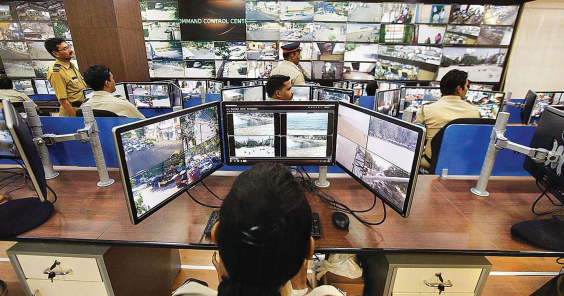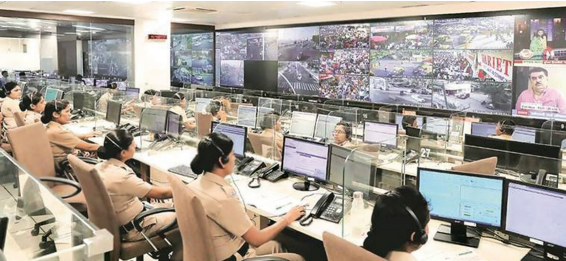Giridhar Gore is a seasoned senior police inspector. He was posted to Crime Branch Department, Belapur, Navi Mumbai, over a year and a half ago. During his long career, he worked alongside remarkable police officers like D Sivanandhan, Satyapal Singh, and Milind Bharambe. He embodies leadership in every sense. His invaluable experience over the decades has stood him in good stead in his present tenure at Belapur. He works tirelessly to bridge the gap between the police and the public, ensuring that citizens feel empowered to seek help in times of need. In an exclusive interview with The Mumbai Protector, Giridhar Gore shares insights working under the CP Navi Mumbai, recounts his experience at the Crime Branch, and his ongoing mission to enhance the working environment for his colleagues and subordinates.
Could you share some
insights into your
professional journey prior to joining Belapur?
My career spans over 25 years, primarily in the Crime Branch of the Mumbai Police. I had the privilege of working under the guidance of former DGP D Sivanandhan and former CP Satyapal Singh. I was part of the investigative team during the 2002 bomb blasts—a challenging yet rewarding experience within an excellent team. I have been in this present post in Belapur, Navi Mumbai for 1.5 years. Prior to this, I was posted in Chembur.
Which is the most
demanding department in your career thus far?
The Crime Branch has consistently been a refreshing challenge for me.
Can you elaborate the changes brought in by CP Navi Mumbai Milind Bharambe?
CP Milind Bharambe Sir has spearheaded numerous impactful and significant initiatives to enhance policing effectiveness and community engagement in Navi Mumbai.
Establishment of Cybercrime Cells: He established a cybercrime cell in every police station. This move has significantly help our officers become more efficient in dealing with cyber-related offenses and boost their efforts to tackle emerging digital threats.
Implementation of the Nelson System: He launched the Nelson System, which advocates for one case, one officer, one month, thus streamlining the investigative process. Based on the complexity of a case, this system helps assign it either to a senior officer or a constable. This ensures that each case receives the appropriate level of expertise and attention. Additionally, we provide comprehensive training to all our staff, empowering them to handle diverse challenges with confidence. As a result of the Nelson System, there is little to no backlog of cases.
Introduction of Yatharth Kits: Sometimes, witnesses become hostile in court or deny the accusations, leading to the case being acquitted. It is very frustrating, after all the efforts we put into. To address challenges related to witness credibility and evidence collection, the use of Yatharth kits has proven instrumental. This is an evidence collection kit. It includes a camera for recording a confession, ensuring us visual evidence is captured, and aiding in securing convictions even when witnesses turn hostile.
Expansion of CCTV Surveillance: Recognising the importance of surveillance in crime prevention, we have identified and covered dark spots with CCTV cameras to prevent criminal activities and enhance overall public safety.
Creation of Nirbhaya Squads and Women Cells: In a bid to create a safer environment for women, Nirbhaya Squads and Women Cells have been established in all police stations. These Cells are led by female officers and constables so as to provide a conducive space for women to report grievances and seek assistance, thereby fostering trust and confidence in law enforcement. Additionally, we have implemented vehicles driven by women officers, enhancing the mobility and accessibility of our forces.
Introduction of Dial 112: Implementing this emergency helpline has proven to be a lifeline for individuals in distress.
Enhanced Forensic Capabilities: Previously, we faced delays in forensic investigations as we had to rely on teams from Thane or Mumbai. The provision of forensic evidence collection bikes at every division has accelerated the process of evidence gathering and analysis has minimised delays and improved investigative
outcomes.
Revamping Police Station Infrastructure: CP Bharambe’s efforts to revamp police station infrastructure has led to cleaner and more professional working environment. The removal of old, unusable vehicles has created space for recreational facilities like badminton courts and open gyms, catering to the well-being of police personnel working long shifts.
You have managed to achieve a very friendly atmosphere in this police station…
Creating a welcoming atmosphere at the police station is vital in ensuring that individuals feel comfortable and supported when seeking assistance. Many people arrive at police stations feeling tense and burdened by their problems. By providing amenities like readily available water bottles and fostering a friendly environment, we aim to relieve some of that tension and make them feel more at ease. It is essential for people to see the police station as a safe space where their concerns will be heard and addressed. While we may not always have immediate solutions to their cases, offering them comfort and reassurance is something we can always provide.
What is your experience working with CP Milind Bharambe?
Working with CP Milind Bharambe has been extremely rewarding. This present assignment stands out as one of the most enriching experiences of my career. Under his leadership, I have been able to acquire valuable technical knowledge and skills. Despite the natural resistance to change that often accompanies new leadership, Bharambe Sir has succeeded in fostering a culture of openness and flexibility among even the most senior officers. Their willingness to embrace change and pursue continuous improvement speaks volumes about his leadership style and the positive impact it has had on the entire department.
Could you share a case that has left a deep imprint on your life?
One case that remains etched in my memory is the tragic discovery of a five-year-old boy’s body behind his building, concealed in a sack. The profoundly shocking incident shook not just the neighbourhood, but the entire community, which consisted of the working-class group. Living in a two-storey building with just one entrance and exit, residents were gripped by fear, realising that if such a tragedy could happen to this child, it could potentially happen to any other child in the neighbourhood. The pressure on our investigation team was immense, as fear rippled through the area, with parents worried for the safety of their own children.
The circumstances surrounding the disappearance of the boy are deeply troubling. While his mother briefly stepped out to get chicken, leaving him and his sister playing downstairs under the watchful eye of a ground floor resident, he mysteriously vanished within a span of 10-15 minutes. Suspicion naturally fell on a building resident who had briefly gone upstairs and had not been seen since, raising concerns about his involvement in the boy’s disappearance.
Adding to the complexity of the situation, the boy and his sister had gone upstairs to change his clothes, after which the sister returned downstairs alone while the boy remained upstairs. The uncertainty surrounding the boy’s whereabouts only deepened the sense of alarm and urgency surrounding the case.
When the mother returned, she inquired from the man where her son was. The man claimed he was upstairs—a statement confirmed by footprints leading in that direction. However, despite this assurance, the boy remained missing, increasing the search efforts. Tragically, half an hour later, the boy’s lifeless body was discovered.
Amidst the investigation, attention turned to a sixteen-year-old girl who shared a close bond with the boy. Despite everyone doubting her involvement, we pursued thorough interrogation. She strongly denied any wrongdoing. However, our inspection revealed a significant detail: all windows in the surrounding area were fitted with grills except at the girl’s house. This pointed to the possibility that the sack containing the boy’s body had been thrown either from the window or the terrace of her residence.
We tried to recreate the scene to prove that the sack had been thrown from that window. We found sacks similar to the one the boy had been found in. We were certain the girl had done something. But since she was a juvenile, there was not much to be done.
After days of questioning, she finally told the truth. The boy, prone to fits, had suffered one while he was at her house. When the boy’s mother returned sooner than expected, she panicked and made a grave mistake by placing a heavy pillow over the boy to silence his cries and assure the mother he was not present at her house. Tragically, this act led to the boy losing consciousness due to suffocation. Believing him to be dead, the girl made a grave decision to dispose his body in a sack and throw it out of the window.
This heartbreaking revelation draws attention to the consequences of fear and desperation, highlighting the urgent need for open communication and support in times of crisis. Had the girl spoken up about the boy’s condition, his life might have been spared.
This is one that I will always remember, because it was not a typical kidnapping and murder case. A five-year-old boy lost his life, and both families would never be the same.






